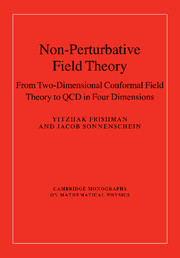Book contents
- Frontmatter
- Contents
- Preface
- Acknowledgements
- PART I NON-PERTURBATIVE METHODS IN TWO-DIMENSIONAL FIELD THEORY
- PART II TWO-DIMENSIONAL NON-PERTURBATIVE GAUGE DYNAMICS
- PART III FROM TWO TO FOUR DIMENSIONS
- 17 Conformal invariance in four-dimensional field theories and in QCD
- 18 Integrability in four-dimensional gauge dynamics
- 19 Large N methods in QCD4
- 20 From 2d bosonized baryons to 4d Skyrmions
- 21 From two-dimensional solitons to four-dimensional magnetic monopoles
- 22 Instantons of QCD
- 23 Summary, conclusions and outlook
- References
- Index
17 - Conformal invariance in four-dimensional field theories and in QCD
Published online by Cambridge University Press: 07 September 2010
- Frontmatter
- Contents
- Preface
- Acknowledgements
- PART I NON-PERTURBATIVE METHODS IN TWO-DIMENSIONAL FIELD THEORY
- PART II TWO-DIMENSIONAL NON-PERTURBATIVE GAUGE DYNAMICS
- PART III FROM TWO TO FOUR DIMENSIONS
- 17 Conformal invariance in four-dimensional field theories and in QCD
- 18 Integrability in four-dimensional gauge dynamics
- 19 Large N methods in QCD4
- 20 From 2d bosonized baryons to 4d Skyrmions
- 21 From two-dimensional solitons to four-dimensional magnetic monopoles
- 22 Instantons of QCD
- 23 Summary, conclusions and outlook
- References
- Index
Summary
Conformal symmetry was shown to be extremely powerful in two-dimensional field theories and obviously also in string theories. This is due to the fact that the conformal algebra is infinite dimensional and hence supplies a set of infinitely many conserved charges. In four dimensions the conformal algebra is finite and therefore less powerful. The purpose of this chapter is to explore the use in 4d conformal field theories of notions and tools that we encountered in two-dimensional CFT, such as primary fields, conformal operator expansion, conformal anomalies and Ward identities.
Free massless theories are obviously scale and conformal invariant. However, field theories that describe the elementary particles of nature and their interactions, are interacting field theories. The question is thus, to what extent can one apply the techniques of CFT to those theories and in particular QCD in four dimensions? QCD with massless quarks is a prototype model of theories which are classically conformal invariant. In fact even for theories with masses and other dimension-full parameters, in certain cases these can be neglected in the high energy and high momentum transfer regime of the theory. However, even in the massless case and with only dimensionless couplings, it is easy to realize that the quantum picture lacks conformal invariance. This follows from the fact that one has to introduce dimension-full parameters such as UV cutoff, which turns into a scale where the coupling is defined, after renormalization.
- Type
- Chapter
- Information
- Non-Perturbative Field TheoryFrom Two Dimensional Conformal Field Theory to QCD in Four Dimensions, pp. 309 - 328Publisher: Cambridge University PressPrint publication year: 2010



